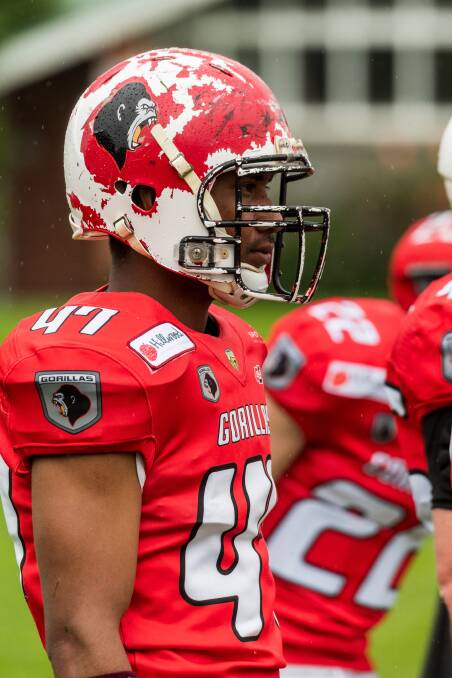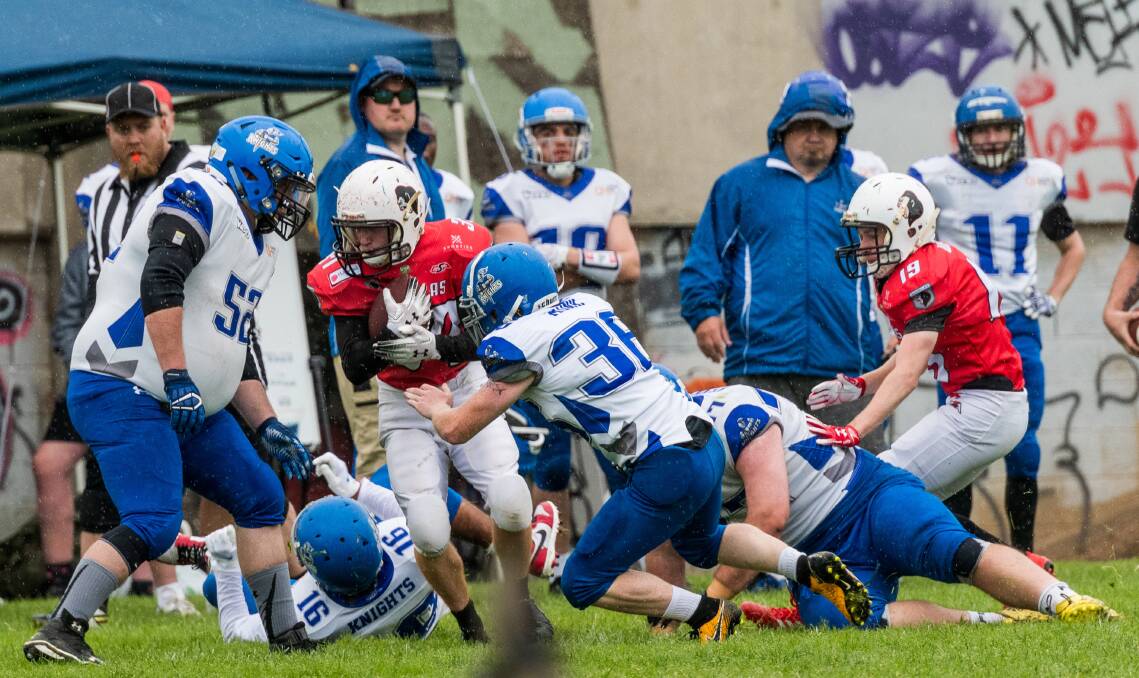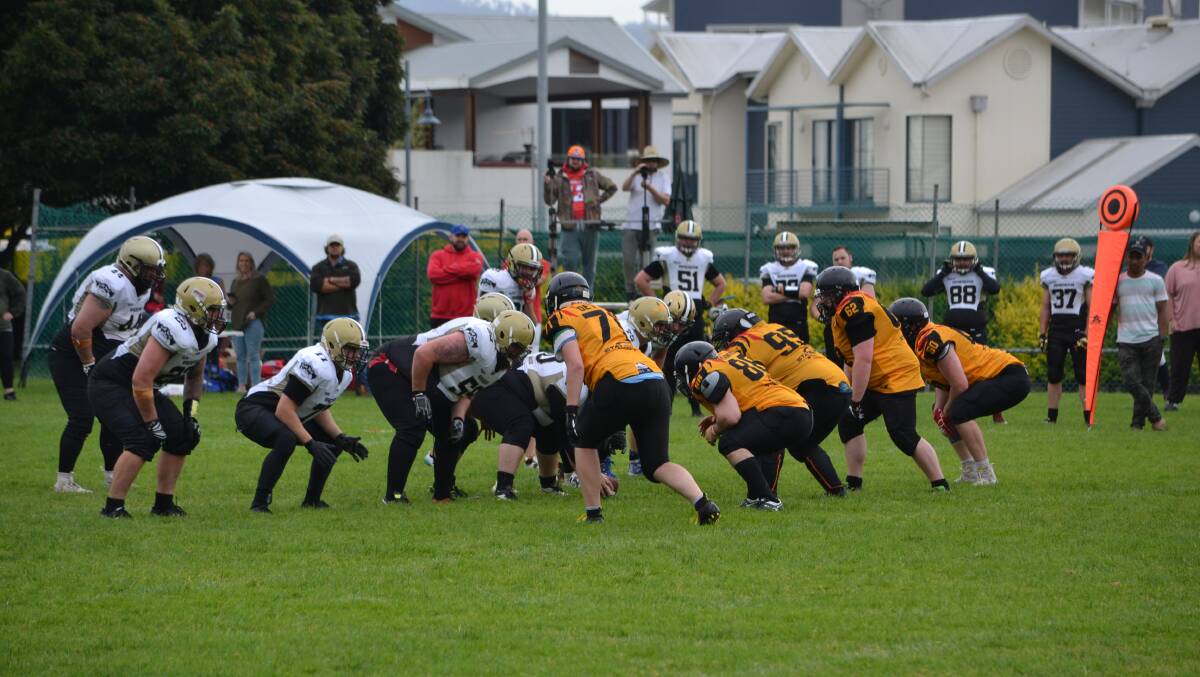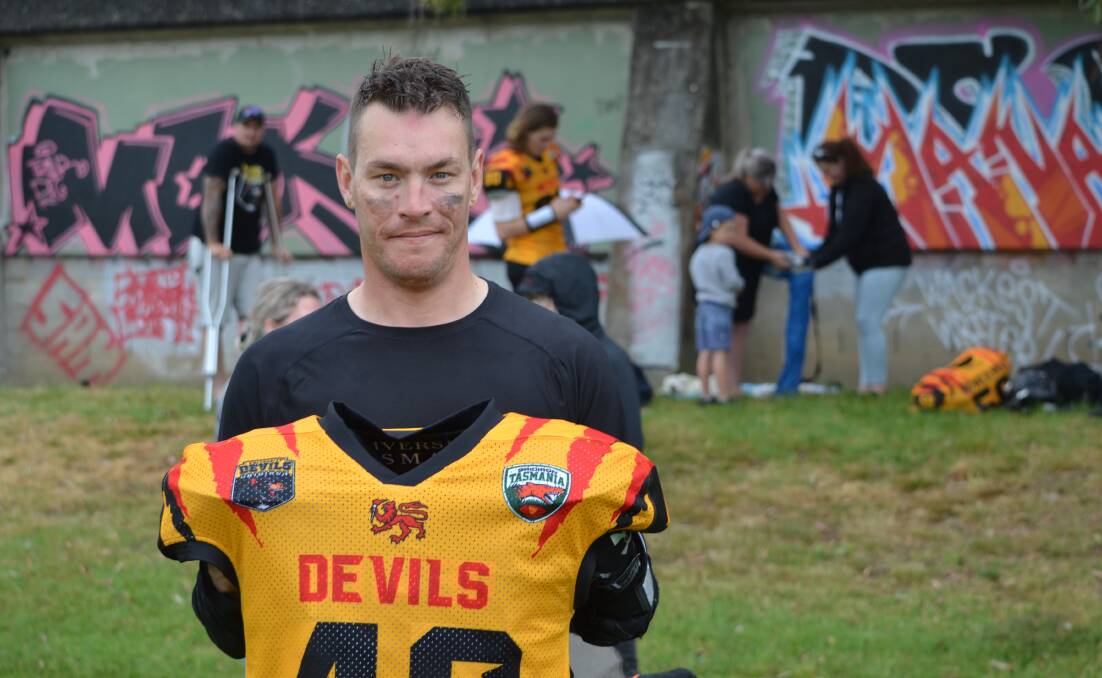
Walking past Launceston's Royal Park last Saturday, you'd be forgiven for thinking you had ended up in Anytown, USA.
Subscribe now for unlimited access.
or signup to continue reading
But the blokey atmosphere, and Australian accents, suggest otherwise: it's gridiron season in Tasmania.
Gridiron Tasmania's president and acting head coach of the Launceston Gorillas Brett Wheldon said the sport continued to be an unknown for many in the Apple Isle.
"It astounds me how often I hear that someone didn't know we played gridiron in Tasmania," he said.
Four teams will spend the next two months travelling the state to face one another, all chasing the coveted Tiger Bowl.
Variety hour
While basketball continues to be the American sport of choice in Tasmania, our trans-pacific cousin's brand of football has carved itself a reasonable following in the state.
There are about 15 positions in American football - this depth of positions and the various physical requirements needed for each of them allow for a variety of body-types to play the sport, according to Wheldon.
"There is a reason that most sports-related feel-good movies are based on gridiron: it is an inclusive sport that allows most people to be able to play," he said.
"It is a true team sport - you have your highlight reel players, but they can't get that highlight without 10 other guys doing their job on the play.
There is a reason that most sports related feel-good movies are based on gridiron: it is an inclusive sport that allows most people to be able to play. It is a true team sport you have your highlight reel players but they can't get that highlight without 10 other guys doing their job on the play.
- Brett Wheldon
"You don't have to be super fit, or super strong to play. These things help and if you have both it's a bonus."

Luke Crowley, of the Hobart Knights, agreed that the game's variety made it accessible to all physiques.
"We have a lot of bigger, stronger guys that enjoy a physical sport where the action comes to them and they don't have to run half a marathon to play," Crowley said.
"Then we have some younger and faster guys that love the big action of the more well known positions, like wide receiver, or runningback.
"I think this is one of the attractions of gridiron for a lot of people. The fact that we can give almost anyone a position and a run - regardless of body size, age or fitness."
In true American style, it was a gridiron video game that got UTAS Devil defensive coordinator and captain Hayden Fischer into the game.
Crowley said his club in the Knights had a variety of ages and athletic abilities, from state sprinters to two players aged over their 50s.
The sport has also allowed for those who are truly passionate to play to have their talent noticed by scouts from the states.

This was the case of Knight Sam Kenner, who received an offer to play football at a college in America.
"But it has been totally stuffed because they closed down due to COVID," Crowley said.
"I actually started playing the video game back in 2000 when I lived in Queensland," he said.
"I went to a training session and I was way too small so when I came home [to Tasmania] I looked it up and the league was just starting."
While many see the slow pace of the game as tedious, Fischer saw it as the game's biggest strength.
"It's the set plays I like - it's a bit like chess, people think it's a lot of stopping and starting but those plays take a long time to practice and a long time to work out. When they come off, it's pretty good," he said.
North-West Raiders president Michael Baran said it was the brotherhood mentality that drove him to the sport.
"I've had a coach tell me it's the closest thing you'll get to combat - you're fighting side-by-side with your brothers against another side you're looking right in the face of ... it's a sport unlike any other," he said.
Eyes downfield
Since its inception, Gridiron Tasmania has continued to grow.
The league started with three teams in the Gorillas, Knights and Devils.
In 2016, the league welcomed a North-West side - the Raiders.
While it's not the NFL, Gridiron Tasmania's slow trend upwards has cause for optimism.

Being with the Knights since day one, Crowley said the increase in participation had been "significant."
"We started with 24 or so players and a single coach and some old equipment," he said.
"Now, in our seventh year, we have 45 registered players, a head coach, 5 positional coaches and some great support staff.
"We have also managed to accrue a significant amount of equipment thanks to a mix of buying second-hand equipment from players and a grant that helped us with a bulk buy from the US a few years ago."
That would prove to be one of the sports' weakness for gaining popularity: equipment.
Unlike Aussie rules, rugby or soccer, America's brand of football demands plenty of padding to be played properly.
"Equipment is definitely a limiting factor for teams, it all has to come in from the US, so we are very susceptible to exchange rates and shipping costs," Crowley said.
Wheldon said if any more expansion of the league were to occur, two teams would need to be introduced in the North and South.
"Personally, I would like to see the development of Junior teams in all clubs which would in turn result in additional players coming up through the ranks. It's a long-term goal but one I believe is the logical way to go."
Despite equipment sourcing, geographical limitations and the relative novelty of the sport in Tasmania, Gridiron Tasmania is working towards fielding a state team to compete in the Australian Gridiron League next year.

COVID season
Like many sporting codes, Tasmania's gridiron season has been altered due to COVID-19.
Wheldon said the league would follow guidelines established by Gridiron Australia, which fall in line with government regulations.
Wheldon said, however the biggest change for the league was the formatting of the season.
"Historically we have played only one game on most weekends with four weekends hosting a two-game gala day," he said.
"Due to the shortening of our season due to other codes running later we are playing two games every weekend to ensure we still finish our season by the end of February."






















